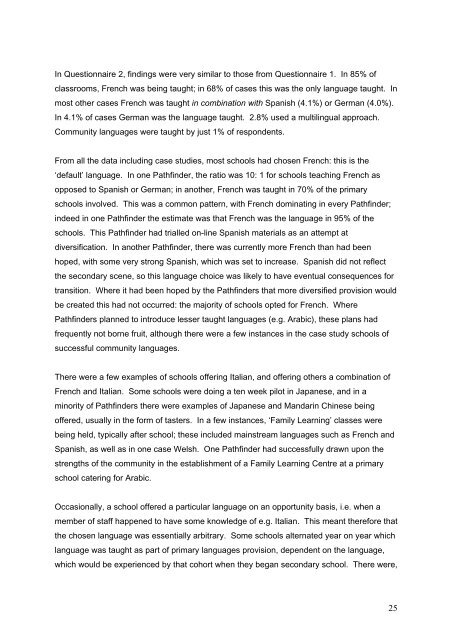Evaluation of the Key Stage 2 Language Learning Pathfinders
Evaluation of the Key Stage 2 Language Learning Pathfinders
Evaluation of the Key Stage 2 Language Learning Pathfinders
Create successful ePaper yourself
Turn your PDF publications into a flip-book with our unique Google optimized e-Paper software.
In Questionnaire 2, findings were very similar to those from Questionnaire 1. In 85% <strong>of</strong>classrooms, French was being taught; in 68% <strong>of</strong> cases this was <strong>the</strong> only language taught. Inmost o<strong>the</strong>r cases French was taught in combination with Spanish (4.1%) or German (4.0%).In 4.1% <strong>of</strong> cases German was <strong>the</strong> language taught. 2.8% used a multilingual approach.Community languages were taught by just 1% <strong>of</strong> respondents.From all <strong>the</strong> data including case studies, most schools had chosen French: this is <strong>the</strong>‘default’ language. In one Pathfinder, <strong>the</strong> ratio was 10: 1 for schools teaching French asopposed to Spanish or German; in ano<strong>the</strong>r, French was taught in 70% <strong>of</strong> <strong>the</strong> primaryschools involved. This was a common pattern, with French dominating in every Pathfinder;indeed in one Pathfinder <strong>the</strong> estimate was that French was <strong>the</strong> language in 95% <strong>of</strong> <strong>the</strong>schools. This Pathfinder had trialled on-line Spanish materials as an attempt atdiversification. In ano<strong>the</strong>r Pathfinder, <strong>the</strong>re was currently more French than had beenhoped, with some very strong Spanish, which was set to increase. Spanish did not reflect<strong>the</strong> secondary scene, so this language choice was likely to have eventual consequences fortransition. Where it had been hoped by <strong>the</strong> <strong>Pathfinders</strong> that more diversified provision wouldbe created this had not occurred: <strong>the</strong> majority <strong>of</strong> schools opted for French. Where<strong>Pathfinders</strong> planned to introduce lesser taught languages (e.g. Arabic), <strong>the</strong>se plans hadfrequently not borne fruit, although <strong>the</strong>re were a few instances in <strong>the</strong> case study schools <strong>of</strong>successful community languages.There were a few examples <strong>of</strong> schools <strong>of</strong>fering Italian, and <strong>of</strong>fering o<strong>the</strong>rs a combination <strong>of</strong>French and Italian. Some schools were doing a ten week pilot in Japanese, and in aminority <strong>of</strong> <strong>Pathfinders</strong> <strong>the</strong>re were examples <strong>of</strong> Japanese and Mandarin Chinese being<strong>of</strong>fered, usually in <strong>the</strong> form <strong>of</strong> tasters. In a few instances, ‘Family <strong>Learning</strong>’ classes werebeing held, typically after school; <strong>the</strong>se included mainstream languages such as French andSpanish, as well as in one case Welsh. One Pathfinder had successfully drawn upon <strong>the</strong>strengths <strong>of</strong> <strong>the</strong> community in <strong>the</strong> establishment <strong>of</strong> a Family <strong>Learning</strong> Centre at a primaryschool catering for Arabic.Occasionally, a school <strong>of</strong>fered a particular language on an opportunity basis, i.e. when amember <strong>of</strong> staff happened to have some knowledge <strong>of</strong> e.g. Italian. This meant <strong>the</strong>refore that<strong>the</strong> chosen language was essentially arbitrary. Some schools alternated year on year whichlanguage was taught as part <strong>of</strong> primary languages provision, dependent on <strong>the</strong> language,which would be experienced by that cohort when <strong>the</strong>y began secondary school. There were,25

















